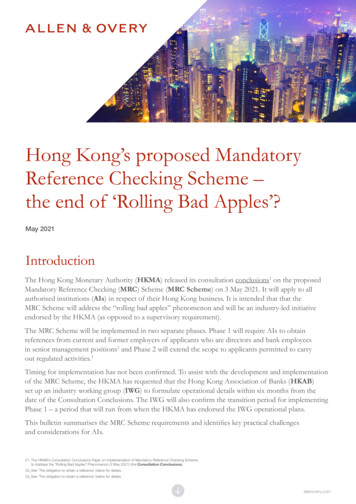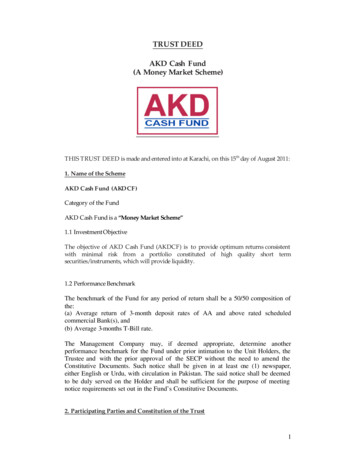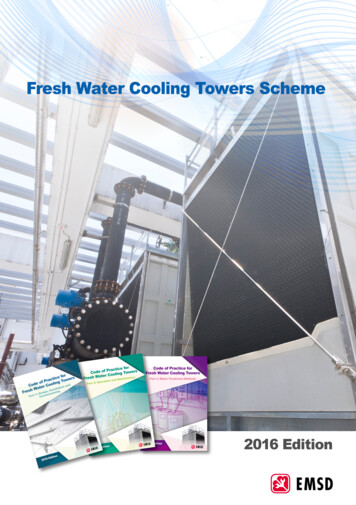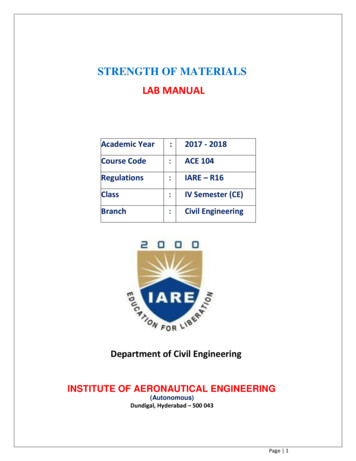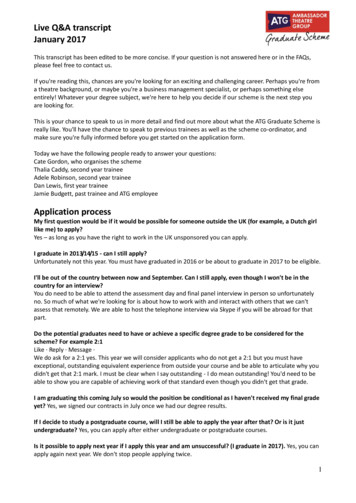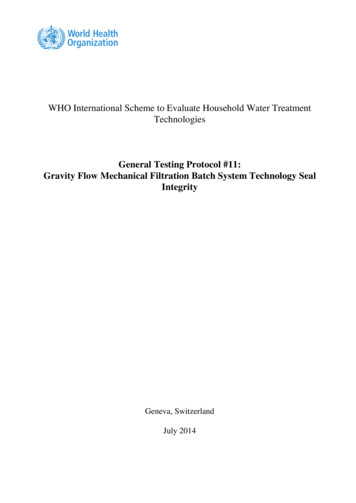
Transcription
WHO International Scheme to Evaluate Household Water TreatmentTechnologiesGeneral Testing Protocol #11:Gravity Flow Mechanical Filtration Batch System Technology SealIntegrityGeneva, SwitzerlandJuly 2014
Table of Contents1. Product Information Requirements . 12. Purpose . 13. Method. 13.1.Replicate samples . 13.2.Test waters . 13.3.Microbiological Organisms and Challenge Concentrations . 23.4.Other Test Details . 43.5.Acceptable reduction deviation . 73.6.Records . 73.7.Completeness. 74. Procedure . 85. Definitions . 106. References . 13List of TablesTable 1General Test Water characteristics2Table 2Microbiological organisms and reduction requirements3Table 3Sampling schedule8
1.PRODUCT INFORMATION REQUIREMENTSThe manufacturer is to provide detailed product information as required in the Expression ofInterest (EoI) which is located on the WHO website at:http://www.who.int/household water/scheme/en/. This information is to include the basicinformation necessary to identify the product and conduct the testing according to themanufacturer’s use instruction, which may include, but not limited to:Flowing system (gravity fed batch stand alone):Flow rateVolumetric capacityPower requirementsOperating pressureMaximum operating pressureOperation instructions – to include: assembly, conditioning, and use instructions, daily operationand maintenance, replacement components, cleaning, backwashing and short term storageinstructions (if any).Manufacturer capacity and supporting information upon which capacity is based.Designated Test LaboratoryThe designated testing laboratory shall be identified.2.PURPOSEThe household water treatment (HWT) product shall be evaluated for seal integrity as microbiologicalperformance based on recommendations and testing principles set forth in the World HealthOrganization’s Evaluating Household Water Treatment Options: Health-based targets andmicrobiological performance specifications (2011). Testing conducted by one of the WHO designatedtesting laboratories shall also be done in line with the terms and conditions outlined in the WHOInternational Scheme to Evaluate Household Water Treatment Technologies Procedure (“Procedure”).The Procedure can be found on the aforementioned WHO website.3.METHOD3.1. Replicate samplesThree (3) production units shall be selected and run as triplicates (3) in one (1) test water.3.2. Test watersTest water shall be prepared daily. An important aspect is that testing will be simulated to model actualfield and use conditions. One (1) type of water will be used: a general test water (GTW) representinghigh quality groundwater or rainwater. Table 1 provides the required test water characteristics andadjustment materials. Following test water preparation, total residual chlorine, pH, turbidity,temperature, total dissolved solids (TDS), and alkalinity shall be measured and reported on the testwater tank. TOC is verified during test water prep as the weight of the adjustment material addition.Sufficient volume shall be collected to allow for a retain volume for back-up analysis, if needed. Thefollowing methods, or equivalent, shall be used:
Chlorine (total): SM 4500-Cl G or UNE-EN ISO 7393-1 pH: SM 4500 H B Turbidity: EPA 180.1 Temperature: SM 2550 TDS: SM 2540C Alkalinity: SM 2320-B TOC: humic or tannic acid addition to the test water volume is to be weighted out based on thecarbon content of the humic or tannic acid and is calculated to be within the test waterspecification range. As an alternate, SM 5310C, in water (GTW, lower TOC); SM 5310B, inwater (CTW, higher TOC) may be used.3.2.1.General test waterThe general test water represents non-stressed phase of testing. Reverse osmosis treated water shallbe used as the base water and adjusted to meet the following characteristics:Table 1:General Test Water characteristicsConstituentChlorine1 (mg/L)SpecificationTurbidity (NTU) 1 NTUNoneInorganic acid or base:Hydrochloric acid (7647-01-0)Sodium hydroxide (1310-73-2)Tannic acid(1401-55-4, Supplier: Alfa Aesar)No adjustmentTemp ( C)20 3oCNot applicablepHTOC (mg/L) 0.05Adjustment Materials (CAS#3)7.0 0.51.05 0.95 mg/LTDS (mg/L)275 225 mg/LAlkalinity2 (mg/L as CaCO3)100 20 mg/LSea Salts, Sigma Chemical Company(7732-18-5)Sodium bicarbonate (144-55-8)1All chlorine shall be removed to below detection limits without the aid of added chemical(s) and is commonlyaccomplished by using activated carbon. Chlorine shall be measured prior to addition of test water adjustmentmaterials. Chloride levels in Challenge Water may cause interference with analytical technique; measurements shall bemade prior to addition of sodium chloride.2Intended to buffer pH. Analyzed values may deviate from this range.3Chemical Abstract Service registration number. Refer to the definition section of this document for additionalinformation.3.3. Microbiological Organisms and Challenge ConcentrationsTable 2 shows the organisms and American Type Culture Collection numbers (ATCC) used inevaluating seal integrity as microbiological performance. The target pretreatment concentrations shallbe sufficient to demonstrate: highly protective, protective, or limited protection.2
Table 2:Microbiological organisms and reduction requirementsOrganismVirus2,3: MS-2 coliphage (ATCC15597-B1, with host organisms: E. coli(ATCC 15597) or Salmonellatyphimurium (WG49 NCTC 12484)and phiX-174 coliophage (ATCC13706-B1) with host organisms:PretreatmentChallenge1 108/LMinimum Required Reduction(log)Highly ProtectiveProtective orLimited Protection 5 3E. coli (ATCC 13706 or ATCC700078)1The pretreatment challenges may constitute greater concentrations than would be anticipated in source waters, butthese are necessary to properly test, analyze, and quantitatively determine the indicated log reductions. Thepretreatment challenge must not be less than that required to demonstrate the geometric mean and standard deviationminimum required reduction described below.2Virus performance claim will be based on the poorest log reduction of the two phages.3Host selection is dependent on method. Refer to Section 3.3.1.4 Organism Methods.3.3.1.Selection of MicroorganismsFor seal integrity for mechanical technologies seeking highly protective or protective, testing shallonly include the surrogates for enteric virus performance.3.3.1.1. Enteric VirusHuman enteric viruses are the smallest pathogens, making them more difficult to remove byphysical processes, such as filtration. Specific viruses may be less sensitive to disinfection thanenteric bacteria and some protozoan parasites. Using human or animal viruses in laboratorytesting is complicated, expensive and given the availability of comparable surrogates, this lateroption was chosen for the Scheme. Two different surrogate bacteriophages, MS-2 and phiX174, shall be used to evaluate the performance of HWT products for performance. In choosingsurrogates, consideration included the wide variety of different viruses’ resistance to potentialtreatment processes that enteric viruses vary greatly in terms of size, isoelectric points, type ofnucleic acid, presence of lipids, and the structure of the proteins in the capsid. Additionally,some treatment systems have more than one mechanism that would remove/inactivate viruses.For example, a filtration system (activated carbon) may be combined with a UV light system.Some viruses may be more easily removed by adsorption to the activated carbon than others, andothers may be more resistant to the UV light. For these reasons and due to not using an actualpathogen, the testing of two bacteriophages, with varying characteristics and responses totreatment processes, shall be used in the assessment of the performance of HWT products.MS-2 and phiX-174 are extensively used bacteriophages as models for human enteric virusremoval by water treatment processes. A great deal is known about the resistance of thesebacteriophages to disinfectants. They are easy to grow to large number. Both are similar size andlack a lipid coat like many of the human enteric viruses.MS-2, 24nm in diameter, is a singled stranded RNA virus, with a low isoelectric point (3.9). A3
low isoelectric point makes it less sticky (adsorbs to a lesser degree) than poliovirus and hasbeen used as a conservative model for removal by adsorption processes. MS-2 is very resistant toinactivation by low-pressure UV light and has been used as a model virus to measure UV lightdose in UV light reactors (collimated beam). It is one of the more hydrophobic non-lipidcontaining viruses.PhiX-174, 25-27nm in diameter, is a single stranded DNA with an isoelectric point of 6.6. It isless hydrophobic than MS-2. Research suggests that it is more resistant to halogen disinfectantslike iodine and chlorine dioxide than MS-2.3.3.1.2. Organism methodsProduction and assay procedures for the microbial challenges and equivalent methods shallinclude, but not be limited to: Coliphage MS-2 (ATCC 15597-B1) shall be prepared and assayed using: The method in Annex A, Section A.8.2.2 of NSF/ANSI 55: Ultraviolet MicrobiologicalWater Treatment Systems (2012); E. coli host ATCC 15597; or NEN-EN-ISO 10705-1 (Detection and enumeration of bacteriophages Part 1: Enumerationof F-specific RNA bacteriophage). Salmonella typhimurium (WG49) host NCTC 12484 or E.coli host ATCC 15597.Analyses shall be conducted in triplicate; the geometric mean and standard deviationfor each water type and across all water types examined shall be reported. Samples shall be stored at a temperature between 1 – 8 C and processed within 24hours of collection. Required sample volume to allow for processing in triplicate and a retain volume: 12ml Coliphage phiX-174 (ATCC 13706-B1) shall be prepared and assayed using: The method in Annex A, Section A.8.2.2 of NSF/ANSI 55: Ultraviolet MicrobiologicalWater Treatment Systems (2012); E. coli (host) ATCC 700078; or NEN-EN-ISO 10705-1 (Detection and enumeration of bacteriophages Part2: Enumerationof somatic coliphages) E. coli host ATCC 700078 or ATCC 13706 Analyses shall be conducted in triplicate; the geometric mean and standarddeviation for each water type and across all water types examined shall be reported. Samples shall be stored at a temperature between 1 – 8 C and processed within 24hours of collection. Required sample volume to allow for processing in triplicate and a retain volume:12 ml.3.4. Other Test Details3.4.1.Untreated controlThe microbiologically spiked test water to be used as the influent challenge concentration, shallalso serve as the untreated control. See Table 2 for concentrations.3.4.2.Blank samplePrior to test initiation, using the GTW, the product shall be tested for the presence of the test4
organisms without microbiological addition to confirm that the product arrived to the laboratoryfree of test organisms. Systems shall flow sufficient volume of GTW, with no microbiologicaladdition, through the system challenge to allow for the collection of the necessary volume foranalysis for the organisms of Table 2.3.4.3.Quality assurance/quality control (QA/QC)The testing laboratory will adhere to the requirements of their QA/QC procedures and ISO 17025requirements and must be able to provide documentation of adherence, which are to include but notbe limited to quality checks on organism stocks, calibration of instruments, testing environmentalcontrols, etc.3.4.4.Product residual or wetted contact material of concernFor products that employ a disinfectant component, the component will be removed from thetreatment for the seal integrity testing.If the data does not already exist, an additional test, separate from the seal integrity testing, toinvestigate the disinfectant residual may be required. The active agent residual shall not constitute athreat to health. The WHO Guidelines for Drinking-water Quality (2011) shall be used to determineacceptable levels in the product water.3.4.5.Microbiological sample pointsSampling for microbial pathogens shall be conducted according to the schedule shown in Table4. Seeding shall be required for microbiological challenge points. Seeding shall be used to purge the system of the uncontaminated water with a sufficientflow of contaminated test water (seeding). The systems shall be exposed to a minimum of10 units void volumes or 1L, whichever is greater, of microbiologically challenged waterper Table 2 immediately prior to sample collection and continued through samplecollection. A ‘sampling event’ includes seeding and sample collection. For batch systems, a full batch shall be used for seeding and the final 500 ml collected andsub-sampled into prepped bottles for microbiological analysis. Additional full batches may beused if seeding or sample collection volume requires additional volume.Sample Collection for GTW: 1 blank sample analyzed for the organism of Table 2 1 pretreatment sample analyzed for organism of Table 2 1 sample for Test Water Characteristics 3 post-treatment samples (1 per unit) analyzed for organism of Table 23.4.6.ConditioningThere shall be no microbiological addition during conditioning, and the volume used forconditioning shall not be counted as accumulated volume in determining test volume.3.4.7.CyclingCycling shall coincide with batch processing, unless product use instructions are such that adifferent approach. Testing shall be according to the use instructions.5
3.4.8.Daily test capacityTest capacity shall be sufficient volume for seeding and sampling. For batch systems, this would bea single full batch, unless this volume does not allow for sufficient seeding and sampling. At whichtime an additional batch(es) would be required.3.4.9.Leakage testFlowing systems shall not leak during test operation. Any leaking during test operation shall berecorded in the laboratory bench sheets.3.4.10. End of testCollection of effluent samples following a single seeding or a full batch.3.4.11. Log reduction calculationTesting shall be conducted simultaneously on the test dictated number of replicates. At eachmicrobiological sampling point, pretreatment/influent and post-treatment/effluent water samplesshall be collected and each analyzed in triplicate.When reporting the geometric means of the triplicate counts, if all three counts are non-detect forthe organism, the geometric mean should be reported to indicate “Less than” ( ). In the event one ormore PFU, CFU, or oocysts are found in one or two of the triplicate counts, the “less than” countsare to be treated as being at the detection limit for the purpose of calculating the geometric meanand standard deviation.Log reductions for the purpose of compliance with this test plan shall be calculated at each samplepoint as follows:The geometric mean (GM) of each triplicate analysis (X) shall be calculated for eachpretreatment/influent sample and replicate post-treatment/effluent as:[1]GM (X1*X2* Xn)(1/n)The geometric mean is defined as the nth root (where n is the count of numbers) of the product ofthe numbers. Such as, the geometric mean of the three numbers is the cube root of their product.The geometric mean applies only to positive numbers. It is also often used for a set of numberswhose values are meant to be multiplied together or are exponential in nature, such as data that willbe reported for the microbiological concentration in the pretreatment/influent and posttreatment/effluent waters of the testing.Example of calculating the geometric mean:Use triplicate post-treatment/effluent analyses results of: 1.00E 02, 7.70E 01, and 9.30E 01.Since there are 3 numbers, the n-th root is the 3rd root. The geometric mean would be:(1.00E 02 * 7.70E 01 * 9.30E 01) 1/3 8.95E 01The log reduction for each replicate at each sample point shall be calculated using the results from[1], shown below as the negative log10 of the GM of each replicate post-treatment/effluent, GMeff,divided by the GM of the pre-treatment/influent, GMinf.[2]Log Reduction -log10(GMeff/GMinf)6
Example of calculating the log reduction:Using an example pretreatment/influent geometric mean of 2.07 E8 units (such as CFU/100mL)and using the above examples reported geometric mean of the triplicate analysis of 8.95E 01 units(CFU/100mL), the log reduction would be:Log10 2.07 E8 - Log10 8.95E 01 log reduction8.31 – 1.95 6.36 log reductionFor reporting purposes, two (2) significant figures shall be reported. For the above example, 6.4would be reported. For evaluation of log reduction against the pass/fail criteria, ASTM StandardE29 Absolute method shall be used, which does not allow for rounding.3.5. Acceptable reduction deviationThree (3) production products for three (3) lots of the product must continuously meet or exceed thereduction requirements shown in Table 2.Each phage is treated separately and the result for the virus log reduction for seal integrity will bebased on the phage for which the product performed the poorest. Additionally, the geometric mean ofall microbiological reductions must meet or exceed the requirements of Table 2. Compliance with therequirements shall be based on the reduction percentage calculation.3.6. RecordsAll pertinent procedures and data shall be recorded and provided in a final report. The general test planfor the product type provides a list of the data that is to be reported.3.7. CompletenessCompleteness is a measure of the number of valid samples and measurements that are obtained duringa test period. Completeness will be measured by tracking the number of valid data results against thespecified requirements in the test plan.7
Completeness will be calculated by the following equation:Percent Completeness (V / T) 100%Where:V number of measurements that are validT total number of measurements planned in the testThe specification for this data quality objective will be to achieve minimum 90% completeness formicrobiological and disinfectant residual samples scheduled in the test plan or one (1) incompletemeasurement (if less than 10 are taken).4.PROCEDURETest waters shall be prepared daily and verified in accordance with Table 1. Daily test watercharacteristics shall be sampled, analyzed and results provided in the final report. All sample volumescollection, both microbiological and chemical shall be collected such that sufficient sample volumeremains after analysis to allow for retain sample. The remaining volume of sample shall be retained forconfirmation or retesting purposes, when necessary. Flows shall be measured and recording at each testday start, at sample collection (start), and at the end of each test day.Table 3.Sampling ScheduleTest Day: Collection pointTest WaterDay 1: Following seeding as the last 500ml of a full batch11GTWMicrobiological TestsInfluentEffluentRefer to Section 3.4.8 Daily test capacity for information on products which require more than a single batch volume.Procedure1. Three systems (3) shall be tested simultaneously.2. Systems shall be conditioned according to the product use instructions.3. General test waters shall meet the characteristics of Table 1.a. Daily test water characteristics shall be sampled, analyzed and results provided in the finalreport.b. Sufficient sample volume shall be collected to allow for a retain volume. One set shall be usedfor analysis and reporting. The second sample shall be retained for confirmation or retestingpurposes, when necessary.4. Devices shall be operated according to the product’s use instructions.a. Test plan permitted system cleanings or backwashes and/or component replacements shall occuras dictated by operator manual/use instruction requirements.b. The laboratory technician(s) shall note daily starting and ending flow rates, flow rates at samplecollection, and any cleaning procedures, and other significant event throughout the testing.5. Testing shall be according to the schedule of Table 4.a. Devices shall be operated based on the product use instructions.8
b. At each microbiological challenge point, the following shall occur:i.Microbiologically spiked challenge water shall be prepared to meet the concentrationsof Table 2. MS-2 and PhiX-174 are compatible for combined challenge.ii.Seeding and sample collection shall occur as:1. A complete batch of microbiologically spiked (Table 2) test water shall passthrough the system, with the final 500ml collected for sample and analysis.2. If a single batch is less than 1L or does not be exposed the system to a minimum of10 units void volumes of microbiologically challenged water, additional batchesshall be passes to achieve seeding and sample collection requirements.iii.A sample shall be collected from the influent challenge and analyzed to confirminfluent concentrations.1. As the influent challenge water for all units was from a single source ofmicrobiologically spiked prepped test water, a single influent sample shall be takenand for analyzed for the organisms of Table 2.2. The influent microbiological shall be collected immediately from themicrobiologically spiked test water after all effluent samples have been collected. Aduplicate volume shall be collected and retained as a backup for confirmation orretesting purposes, when necessary.iv.Microbiological influent and effluent concentrations shall be presented in the finalreport.9
5.DEFINITIONSThe following establishes definitions for terminology used with household water treatment as point-ofuse or point-of-collection disinfectants or units and related components. This list is general for allGeneric Test Plans (GTPs) established under Evaluating Household Water Treatment Options: Healthbased targets and microbiological performance specifications (2011).Active agent: A substance or medium added to or involved in a drinking water treatment process thatrequires direct or sacrificial release of the agent or its degradation product(s) to perform a specificfunctions.Additive: A substance added to water, directly or indirectly, during a drinking water treatmentprocess.Backwash: A reversed flow of water through a media which allows the expelling of collected matterto the drain.Back flush: The references of flow direction through a filter or ion exchange column or membrane toremove particles for cleaning purposes.Bacteriostatic: A biological or chemical agent that stops bacteria from reproducing, while notnecessarily harming them otherwise.Batch treatment: A method in which a fixed quantity of water is processed through a treatment devicein a single treatment cycle.Capacity: The volume of water treated by a system before the system or components of the systemmust be cleaned, regenerated or replaced, as specified by the manufacturer.Challenge water: The mixture of water and contaminants used to test a system for contaminantreduction claims.Chemical Abstract Service (CAS) Registration Number (RN): Unique numerical identifiersassigned by the Chemical Abstracts Service to every chemical described in the open scientificliterature (currently including those described from at least 1957 through the present) and includingelements, isotopes, organic and inorganic compounds, ions, organometallics, metals, nonstructurablematerials. They are referred to as CAS RNs and CAS Numbers. A CAS RN designates only onesubstance, has no chemical significance, and provides a link to information about a specific chemicalsubstance. Chemical compounds can be described in many different ways such as molecular formula,structure diagram, systematic names, generic names, proprietary or trade names, or trivial names. ACAS Registry Number, however, is unique and specific to only one substance. CAS Registry Numbersallow for keeping track of substances because they are unique, can be validated quickly and reliably,and are internationally recognized. As CAS RNs are not dependent upon any system of chemicalnomenclature, they can provide a reliable common link between the various nomenclature terms usedto describe substances and serve as an international resource for chemical substance identifiers used byscientists, industry and regulatory bodies. The assigning agency, Chemical Abstracts Service (CAS) isa function of the American Chemical Society (ACS) and CAS information is copyrighted by the ACS.www.cas.orgCleaning: Removal of residues and other soiling materials.Component: A separate or distinct part of a water treatment system including, but not limited tomembranes, filters, housings, tubing, storage tanks, faucets, valves, and connectors.
Oo/cyst: The environmentally resistant stage in the life cycle of certain parasitic protozoa which areidentified from water samples. These include oocysts of Cryptosporidium and Toxoplasma and cysts ofGiardia and Entamoeba.Daily production rate: The volume of product water produced by the system per day under definedconditions.Disinfection: The process that eliminates (removing, destroying, and inactivating) many or allpathogenic microorganisms with the exception of the bacterial endospore on inanimate objects andliquids.Effluent: The treated water from the outlet of a unit, system, component, or process.Filter: (verb) To pass water through a permeable medium to separate particles from the water. (noun)A device for carrying out the process of filtration consisting of the medium and suitable hardware forconstraining and supporting the medium in the path of the water.Filtration: The process by which particles are separated from water by passing water through apermeable material.Hardness: A measurement of the concentration of divalent and trivalent cations, primarily calciumand magnesium, in drinking water. Hardness is typically expressed as grains per gallon or mg/L ascalcium carbonate.Household Water Treatment (HWT) Technology: A product that is used in households or similarsettings to remove water contaminants that may pose health risks. Priority products for testing will below-cost, appropriate for the poor and generally “free standing” products which only treat enoughwater to serve a limited number of individuals.Influent challenge: The mixture of water and contaminants entering a water treatment system.In-line device: Any device in contact with the water installed on a service line or distribution systemdownstream of the water main and upstream from endpoint devices.Media: Material in a system that forms a water-permeable barrier to the passage of certaincontaminants or otherwise contributes to the reduction of contaminants in water. Medium is thesingular form of media.Membrane: A semi-permeable barrier that allows the passage of water, and depending on membranetype and characteristics, may restrict the passage of microorganisms, particles, molecules, and ions.pH: The negative log of the hydrogen ion concentration a measure of the degree of acidity or alkalinityof an aqueous solution.Post-treatment: The treated water from the outlet of a unit, system, component, or process.Pretreatment challenge: The mixture of water and contaminants entering a water treatment system.Pressure: The force applied to a unit area. Water pressure is normally measured in lb/in2, kilopascals(kPa), or feet or metres of head.Product water: Water that has been treated by the system.Rated service cycle: The capacity or time of operation of a system or component between cleaning,replacement, or regeneration of the treatment medium (media), as specified by the manufacturer.System: A complete water treatment device, including all components needed to connect it to apotable water supply.Total dissolved solids (TDS): The solids remaining when a solution is filtered through a 0.45 μm11
glass filter and the filtrate is evaporated and dried to constant weight at 180 ºC (356 ºF). TDS isexpressed as mg solids per litre of filtrate.Turbidity: A condition caused by the presence of suspended matter, colloidal matter, or both, whichresults in the scattering and absorption of light.Unit void volume: Total water-holding volume with the medium (media) and internal components inplace.Unit volume: Total water-holding volume without the medium (media) or internal components.12
6. REFERENCESThe following references have been assembled as a single list to cover all Generic Test Plans (GTPs)established under Evaluating Household Water Treatment Options: Health-based targets andmicrobiological performance specifications (2011). As such, not all references are applicable to theGTP of this document.American Public Health Association (APHA), American Water Works Association (AWWA), andWater Environment Federation
water tank. TOC is verified during test water prep as the weight of the adjustment material addition. . Sodium hydroxide (1310-73-2) TOC (mg/L) 1.05 0.95 mg/L Tannic acid . membranes, filters, housings, tubing, storage tanks, faucets, valves, and connectors. 11 Oo/cyst: The environmentally resistant stage in the life cycle of certain .
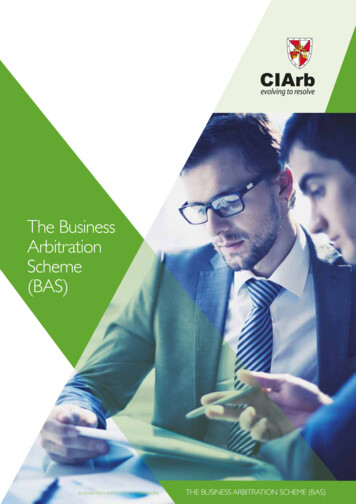
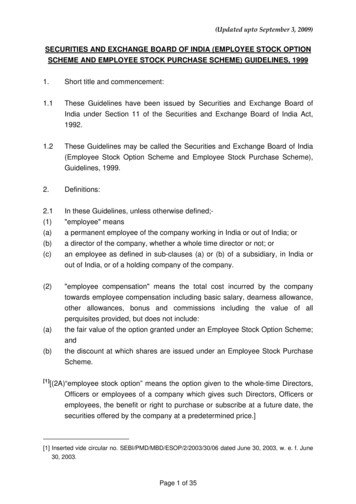
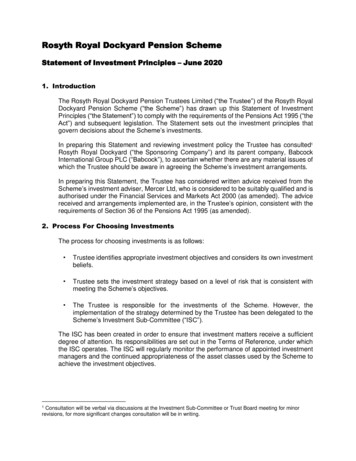
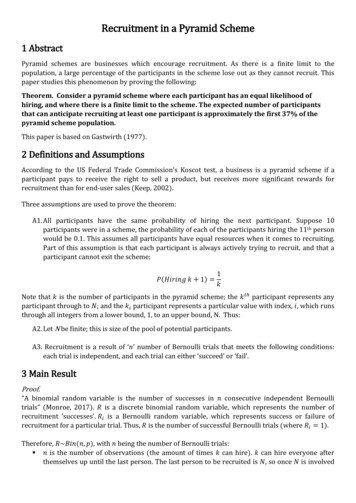
![[Title to come] DSP Dynamic Asset Allocation Fund](/img/24/dsp-dynamic-asset-allocation-fund.jpg)
